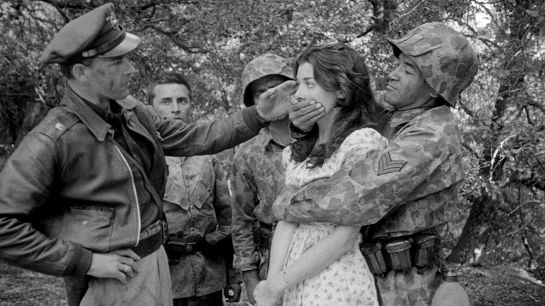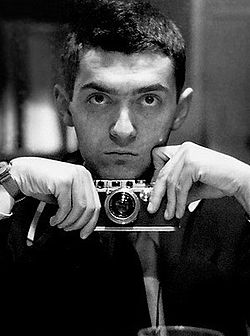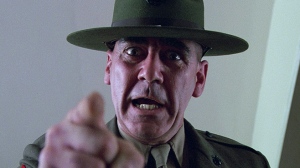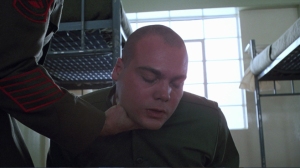There’s nothing like an eccentric and reclusive genius to rouse curiosity and admiration in the general public, and when the reputation is accompanied by an enormous amount of diverse and often contradictory data, the individual in question becomes a mystery that needs to be solved. Well, that’s not going to happen here and probably nowhere else, since Stanley Kubrick died in 1999. The fact that much of the work he wanted to do was never completed, and so, is part of the intrigue, but what did create is legendary in the world of movie history.
Born July 26, 1928 of Jewish immigrant parents in Manhattan, New York, Stanley was reportedly far from a star pupil as a youngster. His father, a physician named Jacob Leonard and his mother, Sadie Gertrude both believed in his native intelligence and tried sending him to an uncle in Pasadena for a change of scenery that might sharpen his learning curve. He was 12 years old at the time; the change didn’t have much effect on his grades or his attitude towards school.
Other efforts definitely did; at least two of Jacob’s early attempts to spark his son’s interest were very successful indeed. When introduced to the game of chess, Stanley took it for his own; he became a highly skilled player and chess became one of the trademarks in his later films. However it was the gift of a camera for his 13th birthday that undoubtedly set the boy on his path to fame, fortune and notoriety.
After several years of traveling around the city of New York and other spots, taking pictures of whatever interested him, Stanley sold some photos to Look Magazine and got a foot in the door of that popular publication. Taking pictures and going to movies at every opportunity over the next few years convinced him that making a film of his own was the way to go. He put together a few documentaries starting with The Day of the Fight in 1951, continuing with Flying Parade and The Seafarers in 1952.
Kubrick’s earliest feature film was Fear and Desire, made in 1953. He raised money from investors – and by using his chess skills to hustle unwary players in Central Park. Fear and Desire is most interesting in that it was written, produced, directed, filmed and edited by him alone, on a miniscule budget that would not make a short commercial today.
The film became available on DVD in 2013, though the story goes that Kubrick hated it and made an effort to remove all copies from circulation during his later years. Every Kubrick fan ought to catch it if only to appreciate the ‘opening scene’ in his cinematic career. CinePassion called the film, “. . . Kubrick’s lugubrious, arresting, disavowed, feature debut . . .”.
His next effort, Killer’s Kiss in 1955, was praised for its inventive and unusual camera work but didn’t go over well at the box office. Undeterred, he teamed up with producer James Harris to make The Killing, his first full-length film with professionals hired to do some of what Kubrick was in the habit of doing himself. However he argued with his crew, and in fact threatened to fire Lucien Ballard, the man hired as cinematographer, who was a pro and a good 20 years older than the then-27-year-old Kubrick.
The Killing didn’t get much acclaim either, partly due to its last-minute promotion, running as second feature to a Western called Bandido. However it has since been re-discovered as one the best films of Kubrick’s early career. It also got the attention of Metro-Goldwyn-Mayer and one of the company’s executives called on the Kubrick/Harris team to be writers, producers and directors for a new film that ended up being Paths of Glory.
Filmed in Munich in 1957 and starring Kirk Douglas, Paths of Glory was the first of Kubrick’s films to be a commercial success, though it was banned for some time in France due to its less-than-salutatory depiction of the French military forces. The movie is based on an anti-war novel written in 1935 and it was about as unsentimental as Kubrick could make it – which is also one of his trademarks, and one reason for the conflicting opinions of his work.
Following that success, Kirk Douglas asked Kubrick to take over direction of another film in which he (Douglas) had the starring role – Spartacus, which would also be a winner at the box-office and in critics’ circles. During production there was plenty of strife on the set in addition to scripted battles. Douglas and Kubrick fought over creative control – not to mention the director cutting the star’s lines to almost nothing in the first half hour of the film.
Disputes notwithstanding, Spartacus won four Academy Awards and even though Kirk and Stanley never worked together again, it was clear to Kubrick, “. . . the youngest director in Hollywood history to helm an epic”, and to the rest of Hollywood’s moguls that Stanley Kubrick a director was capable of great things.
Not a man to back down from challenges, he next tackled what would become a successful and highly controversial project, Lolita, starring James Mason, Sue Lyon, Shelley Winters and Peter Sellers. Filming Lolita in 1960-61 required a move to London, mostly to get away from the censors in Hollywood. Based on Vladimir Nabokov’s novel, the plot involves a middle-aged professor and a 13-year-old girl – pedophilia in most books – but the vast majority of Nabokov’s eroticism had to be cut out and/or camouflaged with comedy, which got the final edition past American and European censors.
The role of Quilty in Lolita also showcased the wildly diverse acting talents of Peter Sellers, which, in turn, won the actor, not one, but three roles in Kubrick’s next film, Dr. Strangelove, or How I Learned to Stop Worrying and Love the Bomb. This was a black comedy and political satire that had Sellers cast in three very different roles, starring along with George C. Scott and Sterling Hayden. Dr. Strangelove received a lot of criticism at the time, in 1964, but it also won a lot of major awards, a pattern that would come to define Kubrick’s work.
That film was also shot in England, due to “technical and political” difficulties; it is interesting that Dr. Strangelove was nominated for four Oscars and did not win any, but it won numerous British film awards including the BAFTA for ‘Best British Film’ and ‘Best Film From Any Source’ and the British Hugo Award as well as various other international kudos. In response to the New York Times critic who said the film showed “. . . contempt for our whole defense establishment”, Kubrick responded that he was a satirist with enough optimism to make a joke, even a brutal joke.
During the next few years Kubrick was involved in several projects that never quite made it to completion – including the epic about Napoleon Bonaparte that he is said to have considered his lifelong goal – it was not until 1968 that his next ground-breaking film came out. 2001: A Space Odyssey remains one of the great Science Fiction classics of all time.
In close collaboration with Arthur C. Clarke, author of the novel by the same name, Kubrick wrote the screenplay – but won the only Oscar of his career for his visual special effects. It was his work on 2001 that later inspired rumors that he was involved in faking the first moon landing in 1969, a conspiracy theory that is still very much alive today.
Many critics rate 2001 as Kubrick’s finest production ever, and omniscient computer HAL has become a sort of icon for cinematic depictions of artificial intelligence. Literally volumes have been written about ‘”he meaning of Kubrick’s Space Odyssey” but there is a general consensus that it is a masterpiece; it’s not certain whether Kubrick would agree.
After that marathon of painstaking research and technical perfectionism, Kubrick launched his next project as one that could be made with minimum time and money; A Clockwork Orange was the result.
Based on the novel by Anthony Burgess, the film was in part an exploration of the 1960s perceived ‘degeneration of youth’ with its violence and sexual freedom.
Again a dark satire with comedic undertones – as opposed to a comedy with dark undertones – the movie was a critical and financial success. However when it was first released in Great Britain, Kubrick actually received death threats after “copycat crimes” were reported based on scenes in the film. He personally took it out of distribution in the UK, and it was not shown there legally again until after his death.
By the 1970s Kubrick’s reputation as an outstanding director was confirmed beyond any doubt; he could make a film about anything that captured his interest. Barry Lyndon, completed in 1975, was another divergence from the norm; it went for three hours and at a leisurely pace that put many movie-goers off but ultimately worked exactly right for what Kubrick was trying to do. Ryan O’Neal was probably the perfect choice – Kubrick’s, of course – for the title role of an ambitious but not terribly bright young Irishman.
Again Kubrick had to move locations during filming; he was reportedly made a target by members of the IRA, and had to pack up and move from Ireland back to England to complete his 18th century epic. Barry Lyndon also underlined the director’s radical perfectionism; one scene with O’Neal required 150 takes before Kubrick was satisfied. However in later discussions the actor had nothing but praise for Kubrick’s methods, and stuck with it for the year it took to complete because he felt part of “something great”. The film was not a commercial success upon release, but has since gained great acclaim.
From historical drama to supernatural horror may be quite a leap, but Kubrick made it with bells and chills on when he made his own version of Stephen King’s novel The Shining. Filming took much longer than anticipated, as was usual for Kubrick’s films, and the cast was subject to his trademark endless repeat takes, but the 1980 film is now considered a horror classic.
The Shining, starring Jack Nicholson, Shelley Duvall and a very young Danny Lloyd in his first acting job, was intended to be scary; it most certainly was, and is. Nicholson outdid himself as the writer going mad from a combination of his own demons and the one lurking in the Overlook Hotel; even with Kubrick’s meticulous scene-setting, some of Nicholson’s ad-libbed remarks and actions made the film an even more intense experience for theatre-goers.
Novelist Stephen King did not like Kubrick’s interpretation of his book and his characters; he re-wrote the screenplay, which was aired as a mini-series in 1997. Regardless of intentions good or bad, Kubrick’s movie is the one destined for cinema history books; King’s version basically flopped.
The same year that The Shining came out, Kubrick began working with two novelists who had written books about the Vietnam War; he wanted to make his own war/anti-war movie, to be as brutal and realistic as the real thing. In that he succeeded, but Full Metal Jacket was partially eclipsed by Platoon, a similarly themed film directed by Oliver Stone, which was released a year before Kubrick’s film came out in 1987.
Most viewers will not be aware that the entire film was made in the disused docklands and a derelict iron works in East London, which are now London’s financial center, and not 20 miles from Kubrick’s home at the time. Aside from the mostly unscripted, now-famous maniacal speech to new recruits delivered by R. Lee Ermey as Gunnery Sergeant Hartman, Full Metal Jacket is about the consequences of war. The message is both horrifying and thought-provoking, not just for audiences but even for the actors involved. Kubrick has said that the film was his answer to Rambo – meaning films that over-simplify and glorify war in general.
The Story Behind Gunnery Sergeant Hartman’s Speech
The final project of Stanley Kubrick’s career was yet another topical leap, this time to the exploration of sexual mores, marriage and reality versus sexual fantasies. Eyes Wide Shut, starring one of Hollywood’s most viewable couples, Tom Cruise and Nicole Kidman, does not qualify as pornography – far from it in fact. The most scathing reviews cited a total lack of ‘titillation’, but much of that is due to censors.
Kubrick had reportedly just finished final editing when he died before the film was released. He had kept all of the production strictly under wraps, and of course that fostered nearly hysterical speculation about a ‘Kubrick porn film’, which did not materialize. Eyes Wide Shut, according to Kubrick himself, was meant to be a psychological drama; he has been quoted as saying it was his best film ever. As always, critics’ opinions differ, but all agree that if nothing else the film is “Kubrickesque”. For fans, that’s all the recommendation needed.
It must be noted that another of Kubrick’s projects, one he had worked on since the early 1970s, was another science fiction film titled A.I. Artificial Intelligence or just A.I. It was finally released, ironically enough, in 2001 by director Steven Spielberg. Kubrick had gone to Spielberg in 1995 with his pre-production notes; it was his contention that the subject matter and special effects were closer to Spielberg’s “sensibilities” than Kubrick’s.
Both men were busy with other projects, but when Stanley Kubrick died unexpectedly in March of 1999, Spielberg went ahead with production, sticking as closely as possible to Kubrick’s vision, and when the film came out the credits showed it was dedicated to Stanley Kubrick. A.I. has since been described as a combination of Kubrick’s cold detachment and Spielberg’s warmhearted optimism.
What’s really fascinating is that in a later interview, Steven Spielberg told interviewers that the critics had it all wrong. He said the reverse was true; all the “sweetest” parts were Stanley’s; the “dark center” of the movie was all his. Stanley, of course, was not around for comment but it certainly makes us wonder what else we might have missed in Kubrick’s long and complicated career.
One of Kubrick’s cast in Full Metal Jacket, in an interview long after the film was released, made the statement about Kubrick that what he expected from an actor was “. . . show up, know your lines and don’t bump into the furniture.” He surely expected more from them than most directors – and almost to a man, or woman, many rate the experience of working with Kubrick as the high point of their careers.
The bottom line would seem to be that Stanley Kubrick always has been and will remain an enigma, a complex individual who brought us a great deal of entertainment and probably some enlightenment, depending on how his films are interpreted. He left quite a legacy for movie buffs and critics to ponder, and since he used each film as ‘experience’ for the next, better film, we can only wish he’d stayed around longer.




























